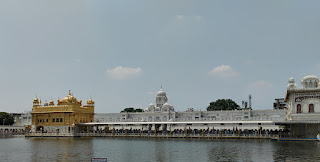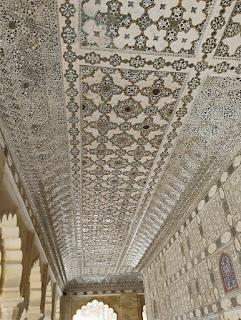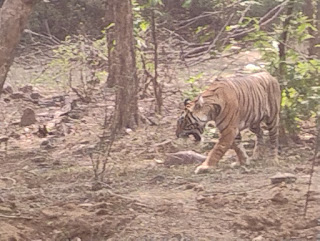3 years after buying the plot of land in Gandia we finally started construction. Its expected to take around 15 months to complete, but of course that is a Spanish estimate....
Where Are The Powells?
Saturday, 11 October 2025
where the powells will be
Wednesday, 27 August 2025
Once more unto the breach
Tuesday, 8 July 2025
India - epilogue
Sunday, 6 July 2025
India - week 10
After the 10 hour bus journey from Shimla, we finally arrived in a very humid Delhi. After check in, we dumped our bags and headed straight to the pool to unwind.
Our hotel near Connaught Place was just steps away from Jantar Mantar
It is one of five Jantar Mantar observatories in India (the most famous one we saw in Jaipur) and translates to "instruments for measuring the harmony of the heavens". It consists of 13 architectural astronomy instruments.
Constructed around 1724, the height of the huge sundial is 220 m.
The main purpose of the observatory was to compile astronomical tables, and to predict the times and movements of the Sun, Moon and planets using the very complex structures.
The Jai Prakash Yantra, has concave and convex hemispherical bowls which were used for precise measurements of celestial bodies.
From there we walked to India Gate, a war memorial dedicated to soldiers of the Indian Army who died between 1914 and 1921 in the First World War and the Third Anglo-Afghan War.
The next day we took the air-conditioned metro to the Red Fort. We had read that this fort and the one in Agra were almost the same, albeit larger, as they were both built in Indo- Islamic Mughal Architecture & Structure. Agra Fort pre dates Delhi Fort by almost 80 years and was built when the Emperor moved his capital to Delhi from Agra.
We had visited many forts and palaces during the last ten weeks and were feeling somewhat jaded especially with the humidity, so we decided not to explore the inside of the fort.
Instead we took the metro to the Lotus Temple. Completed in 1986, its design is based on ancient lotus flowers which symbolise purity and beauty in many cultures. It is constructed of white marble and features nine pools of water surrounding it to give the impression that its floating on water. As with all temples in India, shoes must be removed before entering. Given that there were a number of marble steps up to the entrance, I decided not to look inside, mainly because the soles of my feet aren't made of asbestos!
The next day we took the metro again to see the Swaminarayan Akshardam temple. It's fairly new (2005) and took 11,000 artisans to sculpt and carve out all the surrounds. Unfortunately, this is the only photo I could get as no phones, electronic devices or bags are allowed inside the gate. Inside the complex was beautiful with many sculptures of elephants carved around the base of the temple.
From there we had a tuk tuk take us to Humayun's tomb, another UNESCO site. Built in 1560 pre dating the Taj Mahal by 80 years, Humayun’s Tomb stands within a large garden complex which includes a number of other 16th century Mughal garden-tombs.
The tomb stands in a very significant archaeological setting near the Shrine of the 14th century Sufi Saint, Hazrat Nizamuddin Auliya. It is considered lucky to be buried near a saint’s grave therefore seven hundred years of tomb building has led to the area becoming the densest collection of medieval Islamic buildings in India.
The tomb, its gardens and other attached structures has been the focus of a conservation project in partnership with the Aga Khan Trust for Culture since 1997.
We didn't spend any time walking around the gardens as I was struggling with the heat, humidity and air quality.
The tomb of the noble Isa Khan Niazi is also located within the complex and pre-dates Humayun's tomb by about 20 years. The mosque of Isa Khan is also nearby.
The next couple of days we hit the shops around Connaught Place and Janpath market.
It was then time to say goodbye to India, just as the monsoon finally settled over Delhi. We had changed our plans from 12 weeks to 10 when the local weather authority forecast the monsoon was going to be arriving early.
We had a very early flight to Istanbul then a connection to Dalaman and taxi to Fethiye which turned into a 24 hour travel day. Now it's time to sit by the beach and reminisce about our last 10 weeks.
Wednesday, 25 June 2025
India - week 9
After an overnight stop in Delhi, we boarded a train and headed up to Amritsar. We had a brief walk around when we got there, mainly just to stretch our legs having been on the train for over 6 hours.
Tuesday, 17 June 2025
India - week 8
We've certainly covered some ground this week, 1,580kms by train, plus assorted tuk tuks and safari jeeps, and packed a lot in.
From Udaipur we headed further north to the pink city of Jaipur, and the temperature continued to increase to 40C+
The following morning we visited the Hawa Mahal, also known as "palace of winds" which is part of the City Palace complex. It was built in 1799 and has over 900 small windows decorated with intricate latticework over 5 levels. It was designed so that the royal ladies could observe everyday life and festivals celebrated in the street below without being seen. The many windows also allowed cool air to pass through and so making the whole area more pleasant during the high temperatures. The familiar view is actually the back of the building.
Here is a picture downloaded from Wikipedia,
however, the gods of scaffolding frowned on us once more and this is what we saw
Here are a few photos of the inside.
A short walk around the corner was the City Palace, our next stop. As the Jaipur royal family are in residence there, the ticket prices for foreigners were extortionate, so we chose instead to see the various buildings and museums that are part of the complex.
Here are just a few photos
These vessels are believed to be the largest silver ones in the world. They were crafted to hold holy water from the river Ganges, hopefully without added body.
They each weigh 345kg and can carry approximately 2,000 litres and were used by the Maharaja to carry water to England in 1902 to attend the coronation of King Edward VII.
That evening we headed to the Amber Fort, also called the Amer Palace, to watch the light show from a rooftop restaurant. We couldn't quite hear the narrative but it was nice to see anyway.
The next day we visited Panna Meena ka Kund, a beautiful stepwell constructed in the 16th century and one of the hundreds of ancient stepwells that still exist in India. They were often constructed just outside towns and villages to provide local people with water for drinking, bathing, washing clothes and irrigating crops.
Before it got too hot we went back to the Amber Fort, another UNESCO world heritage site, walked up to and around it. Constructed of red sandstone and marble, the palace is laid out on four levels, each with a courtyard.
This was the Sheesh Mahal, the mirror palace.
We never get a guide as we prefer to see things at our own pace and read the various descriptions. We were wandering around the king's bedroom when a security guard called us over and took us through a closed off restricted area. He showed us a Persian water wheel, clay pots on an endless rope belt driven by men which lifts water up to 20m. The palace has a chain of three or four of these to get water all the way from the lake to the top floor. He told us to look down the enclosure where we saw hundreds of sleeping bats.
He also showed us a few more closed off rooms and passages, so in the end, we had an unofficial guide for a short time.
On the way back to the hotel we stopped briefly to view the Jal Mahal also known as the Water Palace as it's located in the middle of Man Sagar Lake. The palace looks like it's floating on water as its a five-story structure, with four floors submerged underwater.
Later that afternoon we visited Birla Mandir also known as Lakshmi Narayan Temple. It's is a modern Hindu temple built in 1988 and is known for its all-white marble structure and intricate carvings.
From there we headed to Patrika Gate, an entry to Jawahar Circle Garden. It was made of pink limestone and has beautiful murals, designs, and frescoes on each pillar and arch.
The following day saw us on a train once more, this time heading down to Ranthambore National Park. The park is huge and covers a total area of 1,334 km2. It was originally established as a game sanctuary in 1955, then a Project Tiger reserve in 1974 and is known for its Bengal tigers. There are ten zones and we did a total of three safaris. We were lucky enough to see tigers on two of them and a sloth bear on the third, together with lots of other wildlife.
The first safari was in to zone 6 and we saw a tiger called Lakshmi. She was hiding in the trees and we waited to see if she would come down to the stream to drink. After a long time our driver decided to take us to look for other wildlife. When we came back a while later, she had come down to the stream to drink.
The next morning our jeep picked us up at 5.30 and off we went, this time into zone 1. The next tiger we saw was 18 years old called Noor. She was sleeping behind some rocks and her head would pop up occasionally, then go back to sleep. After a while, she'd had enough of us so she got up and walked behind a tree, then slumped down and went back to sleep.
We left her in peace and continued our search, which paid off. Not far from the gate and near a watering hole we found Sultana, Noor's daughter, and her mate Sky. We were lucky enough to get quite close so we were able to observe them for some time.
Then it was back to the hotel for a swim, lunch and relax before our final safari in the afternoon, this time into zone 10. We drove around for some time and saw lots of birds, many species of deer and antelope, peacocks, mongoose, wild pigs and more, but no tigers. Part of the zone was still closed due to a young boy being killed by a tigress a few weeks before. There is a temple near the fort in the park that many locals visit and it is thought that the young tigress, only 22 months old, might have mistaken the boy for a young deer.
On the way back to the watering hole we saw a sloth bear coming out of the trees. He looked just like a shaggy teddy bear.
The next day it was back to Jaipur to get another train to Agra.
The Agra Fort, another UNESCO world heritage site, is also known as the Red Fort and has stood on this site for many centuries. The current structure was rebuilt during the 15th century.
The Taj Mahal is only 2.5kms away
The next morning dawned very overcast so no sunrise over the Taj Mahal but we were at the western gate before 6am and the crowds.
No photos were allowed inside the mausoleum but we saw most of the area before the heavens opened an hour later. Due to the rain, many of the previously drained pools were filled so I was able to get a few really good photos.
Then it was on to Delhi for a night so we could get the train 500kms north to Amritsar.


































































































































